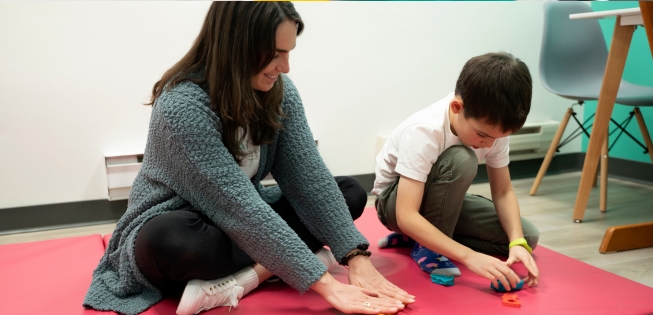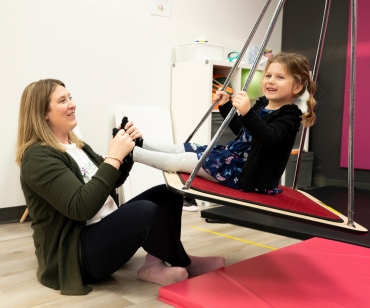
Occupational Therapy
Pediatric Occupational therapists assist children in achieving independence in their day-to-day activities (aka: occupations). These include reaching developmental milestones, self care, play, socializing, and academic tasks.
Treatment and interventions are based on the individual’s needs and could include working on fine motor skills, sensory integration, self-regulation, working on basic life skills and social skills.

Conditions Treated
Occupational Therapy can help kids with the following conditions and more!
- ADHD and attention issues
- Anxiety and stress management
- Autism Spectrum Disorder
- Cerebral Palsy
- Developmental Coordination Disorder
- Dystonia
- Feeding interventions
- Fine motor issues (use of scissors, hand writing, doing up buttons, etc.)
- Global Developmental Delay
- Hypotonia
- Muscular Dystrophy
- Organizational skills
- Rare genetic conditions
- Retained Primitive Reflexes
- Self care
- Self-regulation and emotional awareness and control
- Sensory integration and processing
- Supporting better sleep and sleep hygiene
- Trisomy 21 (Down Syndrome)
- Visual perceptual skills
-
We’ve tried other therapies but they haven’t helped. How is Occupational Therapy different?
Occupational therapy can help your child learn about his/her emotions and how to become more aware of how they are feeling, and learn what they need in order to perform at their best throughout the day.
-
What does a child do during an Occupational Therapy session?
Depending on what your child is coming to therapy for, your session will look a bit different. Sometimes the therapist will bring the child to the gym to work on strength, sensory integration activities (ie: swings, compression, etc) or motor planning and coordination activities. Other times, the therapist will bring games, crafts, writing, or other activities into the therapy room where they can work at a desk.
-
Are Occupational Therapy sessions covered by our Health plan?
Depends. Several but not all health plans will cover OT services. Each provider offers a different plan so check with yours to find out.
-
How can we make Occupational Therapy affordable if we don’t have any coverage?
Give us a call to talk about the right option for you. Sometimes after an initial assessment, your Occupational Therapy will be able to provide you with enough information to make a plan of care that you can work on at home on your own time. Usually having guidance along the way is more beneficial to the child though. Your Occupational Therapy may recommend one of our group programs which gives your child access to our services at a lesser cost because a few children are working together. Another option is to do follow up sessions with an Occupational Therapy Assistant (OTA) since these sessions cost less than they do with an Occupational Therapist. Our Occupational Therapist Assistants are well trained to carry out the Occupational Therapist’s plan of care to ensure continued support for your child.


